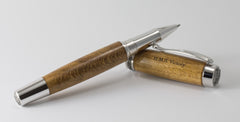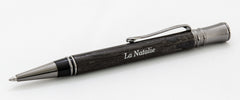Ships of the world
History Salvaged is continually searching for new and exciting Witness Wood® and other materials of historic significance. Hereinbelow is a brief description of some very scarce Witness Wood® acquired by History Salvaged from International vessels.
Because of the rarity of these Witness Woods®, if there is a specific ship and/or pen style or other items you are interested please email Bob@HistorySalvaged.com and we will be happy to work with you to create your perfect custom pen, knife, cufflinks, etc.
HMS VICTORY
History Salvaged is proud to make available an assortment of heirloom quality pens from arguably the most famous ship in the history of the British Royal Navy - His Majesty's Ship Victory.
The HMS Victory is a 104-gun first-rate ship of the line of the Royal Navy, laid down in 1759 and launched in 1765. She is most famous as Lord Nelson's flagship at the Battle of Trafalgar in 1805.
The world's oldest commissioned warship, HMS Victory was taken into dry dock in 1922 in very poor condition and History Salvaged has been able to secure assorted Pitch Pine, Oak and Teak Witness Wood® along with some of the copper that was part of the 30+ tons of materials removed and replaced as part of the 1922 restoration program that returned her to her Trafalgar configuration.
History Salvaged has acquired a collection of wormy oak Witness Wood® that was removed during Victory’s 1950’s repairs and restoration.
HMS INVINCIBLE
History Salvaged has acquired Witness Wood® from His Majesty’s Ship Invincible rediscovered in 1979.
The wreck of HMS Invincible lay covered and forgotten until in May 1979 when a fisherman snagged his nets and got a local diver to investigate. The dives produced a wealth of store items in the preserved lower decks and most items and the Witness Wood® acquired by History Salvaged were sold through a London auction house in the late 1980s.
The 74-gun warship L’ Invincible was captured from the French at the Battle of Cape Finisterre on the 3rd of May 1747. She was escorting a massive convoy of merchant ships when the British channel fleet of 13 warships sighted the convoy and gave chase.
L’ Invincible took on six warships and only struck her colors when most of the crew was either dead or wounded. After capture, she became the Royal Navy’s first HMS Invincible. At the time most warships were much smaller than the 74-gun HMS Invincible and France was ahead of Britain in ship development. Her design revolutionized British ship design as in 1747 there were no 74’s in the British Navy. By the Battle of Trafalgar in 1805 three quarters of British ships of the line were 74’s.
In February 1758, HMS Invincible was part of a large fleet of warships and transports at anchor in St Helens Roads off the Isle of Wight. Early on the 19th, the fleet sailed but unfortunately, the Invincible struck the Horse Tail Sandbank. Over the next days' stores and many guns were taken off the ship but finally, on the 22nd February 1758, she rolled onto her side and was lost.
Over the next 200 years, the ship and her contents have slowly been affected by worms and decay and resulting in Witness Wood® artifacts are very rare.
CLIPPER CUTTY SARK
History Salvaged has acquired several pieces of original construction Witness Wood® (some with remnants of white paint still present) from the most famous Tea Clipper in existence, Clipper Cutty Sark.
The Cutty Sark is a merchant Clipper Ship, built-in 1869 and the last clipper to be built for that purpose. She also served as a training ship until put on public display in 1954. The Cutty Sark is now preserved in a dry dock at Greenwich, London and was severely damaged by a fire in May 2007 while undergoing an extensive restoration.
The Cutty Sark was designed by Hercules Linton and built-in 1869 at Dumbarton, Scotland by the firm of Scott & Linton for Captain John "Jock" "White Hat" Willis. She was launched on November 22, 1869.
Cutty Sark was destined for the tea trade, which in the late 19 century was an intensely competitive race across the globe from China to London, with immense profits to the ship to arrive with the first tea of the year.
It was not long until Clippers lost out to steamships that could pass through the Suez Canal which opened in 1869 and deliver goods more reliably, although not quite so quickly, which proved to be better for business. Notably, during the transition period to steam the Cutty Sark sailed faster than some steamships, After the Tea Trade, the Cutty Sark was used on the Australian wool trade.
In 1895 the Cutty Sark was sold her to the Portuguese firm of Ferreira and renamed. In 1916 she was dismasted off the Cape of Good Hope, sold, re-rigged in Cape Town as a Barquentine and renamed again. In 1922 she was bought and restored her to her original appearance and used as a stationary training ship and in 1954 she was moved to a custom-built dry-dock at Greenwich.
La NATALIE
History Salvaged has acquired from a California Museum collection, a one of a kind, piece of teak Witness Wood®, originally milled in Australia, from the vessel La Natalie.
La Natalie, which sank in1833, is a very interesting ship with a more interesting history. Originally, La Natalie, was a French sloop of war named the Inconstant, the vessel used by Napoleon to escape from Elba to France. It was then captured by allied powers and sold to a Mexican trading company, which was then sold to the United States as a merchant vessel.
Traveling to Monterey Bay, La Natalie carried Mexican national Don Jose Abrego when she sank on December 1, 1833. In 1834, wood recovered from the La Natalie was used by Don Jose Abrego to build Casa Abrego, a wonderful example of early 19th-century adobe construction, which still stands and is preserved as a California State Historic Site in Monterey.
This is an amazing piece of Witness Wood® that has drawn much attention through the years.
Following a storm in 1924 that exposed the vessel, there were literally hundreds of articles about “Natalie” nationwide, including the magazine section of the New York Times of October 26th that contained an article called “Last of Napoleon's Ship of Hope”.
“The article is descriptive of the "Natalie" which was dug up so recently out of the sand of Monterey Bay. This ship was wrecked December 1st, 1833 and was later identified by a French officer as the French sloop of war "Inconstant". Napoleon sailed from Elba on the "Inconstant" Feb. 20, 1815, and landed a week later near Cannes, France, just 100 days before the Battle of Waterloo.
The sloop was later sold to a Mexican Trading company, who in turn sold her to an American company that changed her name to "Natalie".”
The French officer identified the "Natalie" as the "Inconstant" in 1846. Part of the bow was salvaged long before the turn of the century and was housed in the De Young Museum in Golden Gate Park, San Francisco.
This unique piece of Witness Wood® is in amazing condition considering this vessel sank 181 years ago and the wood sat in the ocean for almost 100 years. The wormholes throughout, sand and decomposing areas will prove challenging to our Master Pen Makers and Knife Makers.
SS GREAT BRITAIN
History Salvaged has purchased a large piece of Witness Wood® from the SS Great Britain.
SS Great Britain is a museum ship and former passenger steamship that was very advanced for her time. She was the longest passenger ship in the world from 1845 to 1854, designed by Isambard Kingdom Brunel for the Great Western Steamship Company’s transatlantic service between Bristol and New York. While other ships had been built of iron or equipped with a screw propeller, Great Britain was the first to combine these features in a large ocean-going ship. She was the first iron steamer to cross the Atlantic, which she did in 1845, in the time of 14 days.
When launched in 1843, Great Britain was by far the largest vessel afloat. However, her protracted construction and high cost had left her owners in a difficult financial position, and they were forced out of business in 1846 after the ship was stranded by a gross navigational error.
Sold for salvage and repaired, Great Britain carried thousands of immigrants to Australia until converted to sail in 1881. Three years later, she was retired to the Falkland Islands where she was used as a warehouse, quarantine ship, and coal hulk until she was scuttled in 1937.
In 1970, following a cash donation by Sir Jack Hayward that paid for the vessel to be towed back to the UK, Great Britain was returned to the Bristol dry dock where she was built. She is now listed as part of the National Historic Fleet and is an award-winning visitor attraction and, with 150,000–170,000 visitors annually.








